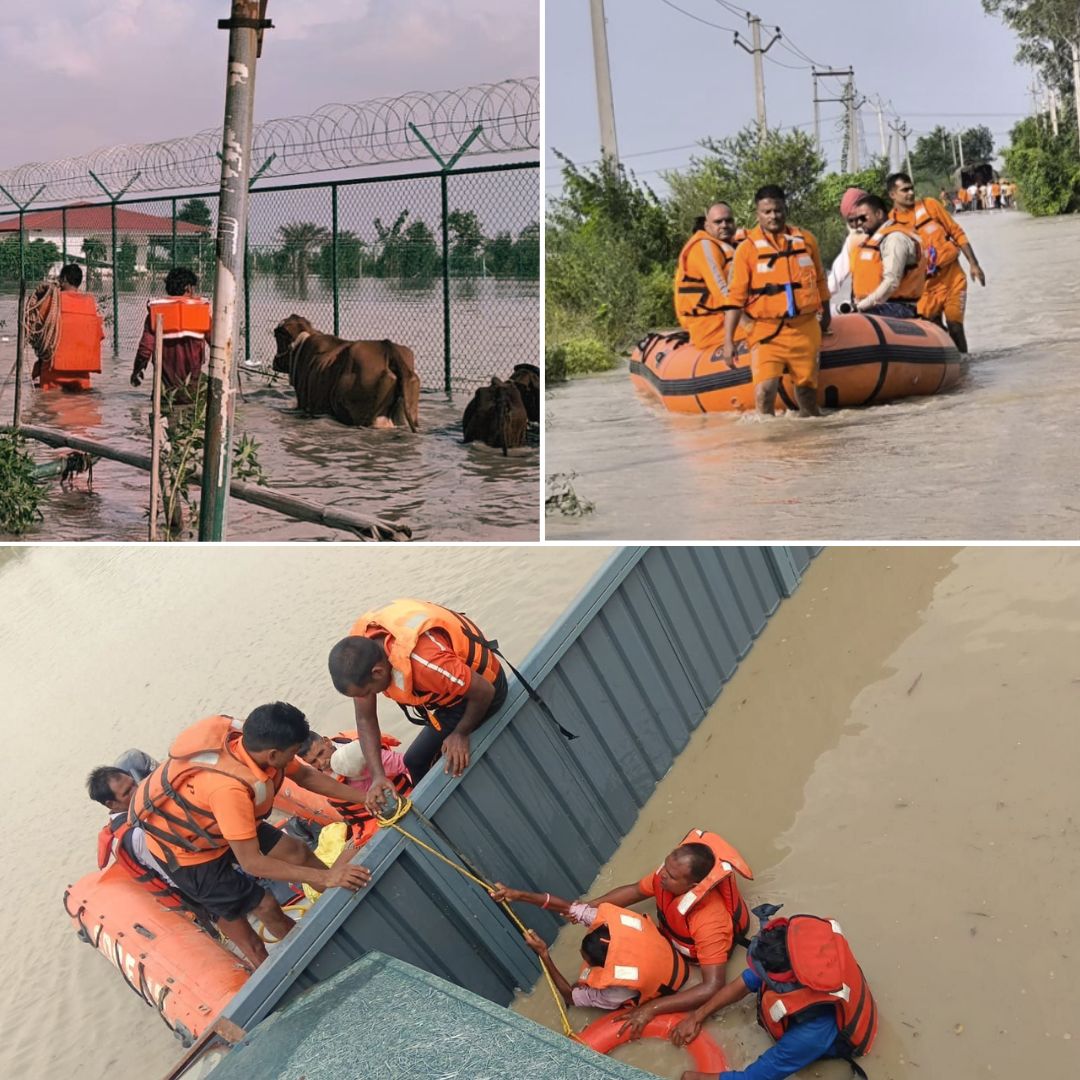Noida’s Sector 135 and surrounding villages have experienced severe flooding after the Yamuna River breached its danger mark, displacing over 3,500 people and submerging farmhouses and agricultural fields.
Relief shelters have been set up for evacuees, while authorities and disaster response teams work to provide essential aid and animal rescue. Though the river’s water level has begun to recede slightly, significant damage remains with many facing uncertain futures.
Flood Impact and Human Stories
Low-lying areas in Sector 135, including Nagli Wajidpur village, and other sectors such as 126, 128, and 167, have been heavily inundated. Many residents had to leave homes with only basic belongings as water reached waist-deep levels overnight.
Farmhouses and crops including millet and paddy were submerged, destroying the livelihoods of farmers from Junpat village, who laments the loss of his hard work due to repeated floods. Concerns about livestock are acute; farmers like Iqbal from Azgarpur village keep constant watch over cows and buffaloes relocated to temporary shelters, fearing disease or death.
Community kitchens operated by local farm owners, alongside official relief efforts, provide food and medical aid at centres like Nagli Wajidpur, housing around 600 evacuees.
Ongoing Relief and Official Measures
Authorities have activated multiple relief camps and flood posts across Gautam Budh Nagar district, with agencies such as the National Disaster Response Force (NDRF), State Disaster Response Force (SDRF), Provincial Armed Constabulary (PAC), and fire services conducting rescues and maintaining vigilance.
Approximately 2,600 people remain housed in 15 shelters receiving round-the-clock medical care, food, and clean water. Over 1,400 cattle have been rescued and relocated from flooded shelters in the area. The irrigation department has reported a decline in river discharge levels at major barrages, signaling a possible easing of flood pressure if upstream rains cease.
Officials like Noida authority CEO Lokesh M affirm that every effort is underway to meet displaced families’ urgent needs and prevent secondary crises such as waterborne diseases.
Background and Environmental Context
This flood event is a recurring consequence of heavy upstream rainfall and sustained water discharge from the Hathnikund and Okhla barrages which feed into the Yamuna. The floodplains on Noida’s edge are especially vulnerable due to low elevation and unplanned construction of farmhouses and settlements.
Local meteorological data indicate persistent humidity and rainfall contributing to the river’s swelling beyond the danger mark of 200.6 metres at the Old Railway Bridge flood forecasting station. Past flood events have similarly submerged large tracts of land, highlighting chronic infrastructure gaps in embankment robustness and drainage capacity.
The district’s flood management strategy includes constant monitoring, early warnings, and coordinated evacuations to minimise loss of life.
The Logical Indian’s Perspective
This distressing situation in Noida exemplifies the pressing need for integrated flood management policies that marry urban planning with ecological stewardship and social equity. It calls for greater government accountability to reinforce infrastructure, transparent communication with vulnerable communities, and sustained investments in disaster preparedness.
The Logical Indian advocates for fostering a culture of empathy and solidarity by supporting displaced residents, especially farmers and labourers, as they rebuild their livelihoods. Flooding is not just an environmental problem but a social justice challenge demanding compassionate governance and collaborative resilience-building.
यमुना नदी में बढ़ते जल स्तर को लेकर जिला प्रशासन अलर्ट, प्रभावित क्षेत्रों से लोगों को रेस्क्यू कर शरणालयों में किया जा रहा है शिफ्ट, शरणालयों में निवास कर रहे लोगों के लिए मेडिकल, खान-पान व अन्य मूलभूत सुविधाओं की, की गई है सुदृढ़ व्यवस्था।@chiefSecyUP@CMOffice pic.twitter.com/H5QeE0mxUz
— Medha Roopam (@MedhaRoopam) September 4, 2025
आज, दिनांक 03.09.2025 को सैक्टर-150, यमुना पुस्तै क्षेत्र स्थित बाढ़ पुनर्वास स्थल का निरीक्षण कर प्रभावित नागरिकों से संवाद किया गया। निरीक्षण के दौरान अधिकारियों को त्वरित राहत कार्य सुनिश्चित करने के निर्देश दिए गए।#NoidaAuthority#FloodRelief#PublicWelfare#UrbanGovernance… pic.twitter.com/wKOqCE2QYz
— CEO, NOIDA Authority (@CeoNoida) September 3, 2025












